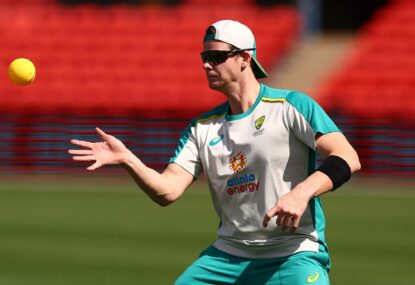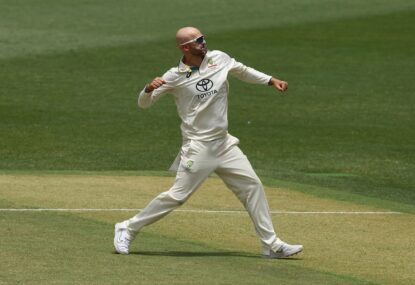The Australian’s come to St George’s Park, Port Elizabeth on Thursday, almost 17 years to the day since Mark Waugh’s century that guided Australia to a two-wicket victory in the second Test at the self-same ground.
Waugh, who was playing his 100th Test by the way, said of his innings of 116 in pursuit of 270 for victory, “My hundred in Jamaica comes pretty close, but this was definitely the best.”
Australia, who were chasing 270 on a difficult wicket, seemed to be cruising, but lost three wickets in 11 balls to jangle the nerves.
Then Ian Healy spoiled a possible South Africa victory party by hitting Hansie Cronje over square leg for six to seal the match for the Aussies.
Australia had won the first Test by an innings and 196 runs in Johannesburg and eventually won the three-match series 2-1. This was South Africa’s first defeat in a home Test series since returning to international cricket in 1991/92 after more than two decades in the doldrums.
Mark ‘Tubby’ Taylor had on the other hand, in that 1997 series, led Australia to their first series win over South Africa since 1957/58, and it was no doubt bittersweet, as he had gone 18 successive innings without a Test 50.
Geoff Marsh, whose son Shaun carved a masterly 148 at Centurion, was the coach in 1997. He said at the time he was standing by his captain, Taylor, despite calls for him to be axed due to poor form:
“He’s a tougher man than you and I. We are all 100 percent behind him. Every day we do as much as we can to help him.
“The way he carries himself in the dressing-room is unbelievable because he is so disappointed with his own form.”
And who will forget the 3-0 hammering the Australia side under Bill Lawry endured at the hands of Ali Bacher’s charges in the 1970s, with St George’s Park being the scene of the Aussies’ swansong in the third and final Test, going down by 323 runs.
It was to be SA’s final appearance on the world Test stage due to the international sporting isolation, until their 1991 breakthrough tour to India.
It is interesting to note of the 24 Tests played in total at St George’s, 20 have produced results, the last being a South Africa victory over New Zealand by an innings and 193 runs in January last year.
In that Test in the Proteas’ first innings of 525 there were three centurions, Hashim Amla (110) Faf du Plessis (137) and debutant Dean Elgar (103).
BJ Watling’s 63 in the Kiwis’ first innings total of 121 was their high score in an innings which also featured four ducks. New Zealand then were bowled out for 211 in their second innings, a better but far from ideal effort, that gave the Proteas a runaway victory.
So what do we make of the St George’s Park pitch then?
It used to be notorious for being a no-result pitch when it came to provincial cricket back in the day, but yet Test results show a different trend.
In the 1980s when ex-Aussie national Kepler Wessels reignited the local Eastern Province provincial side, winning Castle Cup trophies and one-day competitions along the way, St George’s, the side’s home ground, was always labelled a dead wicket.
It did offer a little bit for the spinner, but by and large it was considered a ‘batsman’s paradise’ as it offered hardly any swing and seam movement for seamers, nor bounce for the express quicks.
Just look at the Test against New Zealand last year – three centuries does tell you something.
However, the batsman’s paradise label changed post-1980s, due to science involved in laying of pitches, changing weather conditions and tough standards set by the controlling body for cricket in the new dispensation (United Cricket Board and CSA).
Many Tests call for an equal contest between bat and ball, which St George’s has provided of late; there will be plenty of carry come Thursday, but being St George’s, possibly still not as hostile as Centurion or the WACA of course, but enough in it for the seamers – if they put their back into it.
The one thing locals knew is though St George’s was known to be a dead pitch back in the day, it would provide turn on the fifth as the bowlers’ footmarks and general wear and tear of the pitch offered something for the spinners.
Hot and humid weather can also make for seamer-friendly conditions and Port Elizabeth has been basking in very hot, uncomfortable and balmy weather of late, reaching highs of 28–30 degrees Celsius (83 Fahrenheit), with humidity as high as 90 percent – which is normal for this time of the year the weather forecasters say.
According to a forward forecast, Thursday might be a bit cloudy at first in the morning, warming up later.
So I guess swing bowlers might be able to exploit any such conditions first up. Expect temperatures to be mild, low to mid-20s for the first three days.
Except for afternoon showers on the Thursday, according to the forecast, Friday and Saturday looks pretty perfect for Test cricket, with temperatures staying in the mid-20s.
Port Elizabeth is not known as the ‘windy city’ for nothing, so expect a stiff south-easterly breeze to blow, sometimes cross-field. If it blows from the sea, the wind might make it difficult for bowlers bowling from the new Graeme Pollock Stand.
The likes of Ryan Harris and Ryan McLaren might be the workhorses called upon to bowl into the wind if required for their respective sides.
Also St George’s is a comparatively a smaller ground with a lot of history … the stands literally hug the ground and the square leg boundaries are not the biggest.
Then there’s the local band to contend with, who start up not only when South Africa are taking wickets or scoring runs, but also if their team is in a tight situation. They will be giving the Aussies a hard time indeed.
Another side issue (that should have no say in the staging of the Test at all), is the fact Eastern Province Cricket has been placed under temporary administration due to problems with an election process as it concerns to the Eastern Province executive, which runs EP cricket.
A High Court judge earlier this month declared the board invalid, after five clubs representing other clubs in the region took EP Cricket to court to fight and dispute the election process which saw officials elected onto the executive in October last year.
The judge ruled in favour of the five clubs and ordered EP Cricket to carry the costs of the judgement, believed to be R1-million.
According to a report in the EP Herald newspaper in the city: “In his ruling, Judge Kroon instructed, among other things, that: ‘The election of officials to the board of EP Cricket at the adjourned annual general meeting on October 26 be declared invalid and set aside.’
“EP Cricket acting chief executive Tono Mle reconvene an annual meeting with 30 business days’ written notice to all members of EP Cricket, for the sole purpose of electing a board.”
The process of declaring positions invalid has now been communicated to said officials, who have left office and new elections will take place in March.
In the meantime, as per the instruction by the judge, controlling body Cricket South Africa has appointed an administrator, Mr Max Jordaan, to run the affairs of EP Cricket until the March elections are held, to ensure the cricket Test can go ahead unhindered.
Never a dull day as it concerns politics in South Africa sport, no matter on what level.
That aside, it should be five days of crackerjack Test cricket – if it goes the distance that is!






































































































